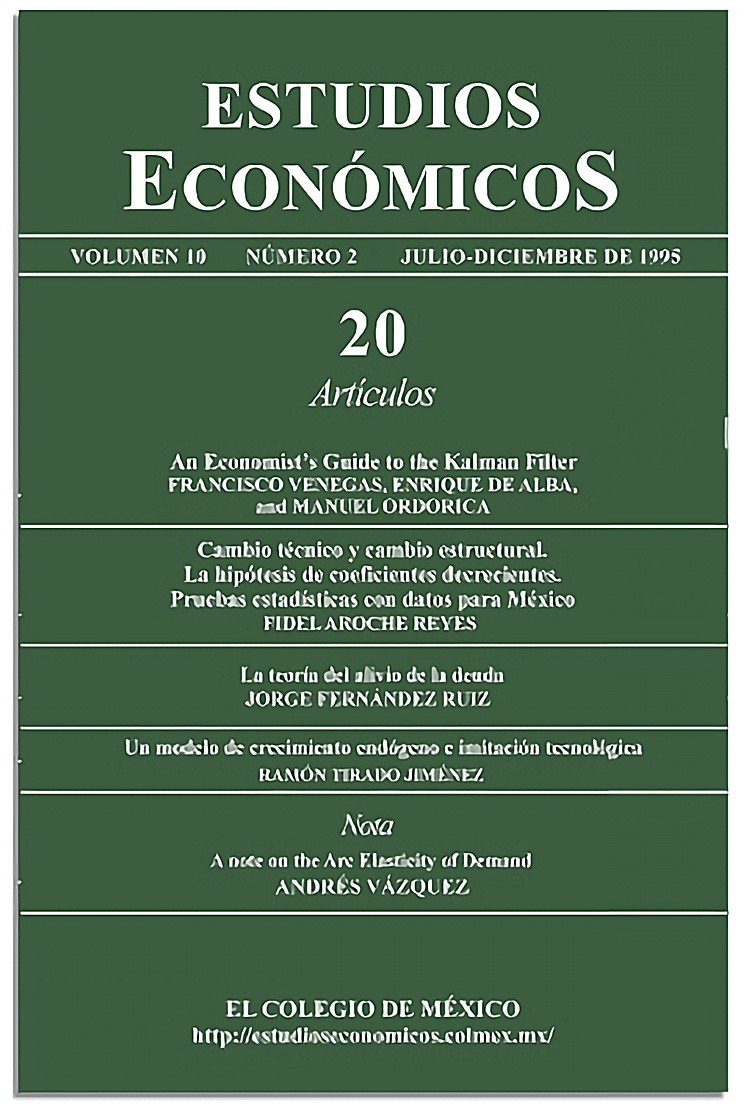Published 1995-07-01
Keywords
- economic crisis,
- external debt,
- developing countries,
- bargaining models
How to Cite
Fernández, J. (1995). The debt relief theory. Estudios Económicos De El Colegio De México, 10(2), 163–193. https://doi.org/10.24201/ee.v10i2.266
Abstract
The LDC debt crisis has spurred a series of models which allow for the analysis of relief proposals. This paper studies some aspects of these models. Debt-buybacks, debt-equity swaps and the case for pure debt forgiveness are reviewed. Some bargaining models are also analyzed.
Downloads
Download data is not yet available.
References
- Acharya, S. e I. Diwan (1993). "Debt Buybacks Signal Sovereign Countries' Creditworthiness", International Economic Review, vol. 34, pp. 795-818.
- Armendàriz de Aghion, B. (1990). "International Debt. An Explanation of the Commercial Banks Economics, vol. 28, pp. 173-186.
- Aizenman, J. (1991). "Trade Dependency, Bargaining and External Debt", Journal of International Economics, vol. 31, 101-120.
- Bulow, J. y K. Rogoff (1988). "The Buyback Boondoggle", Brookings Papers on Economic Activity, vol. 2, pp. 675-698.
- Bulow, J. y K. Rogoff (1989). "A Constant Recontracting Model of Sovereign Debt", Journal of Political Economy, vol. 97, pp. 155-178.
- Bulow, J. y K. Rogoff (1991). "Sovereign Debt Repurchases: No Cure for Overhang", Quarterly Journal of Economics, vol. 151, pp. 1219-1235.
- Fernández, J. (1993). "Debt and Incentives in a Dynamic Context", CEE, El Colegio de México, Serie documentos de trabajo del CEE, núm. I.
- Fernández, R. y J. Glazer (1990). "The Scope for Collusive Behavior Among Debtor Countries", Journal of Development Economics, vol. 32, 297-313.
- Froot, K. A. (1989) "Buybacks, Exit Bonds and the Optimality of Debt and Liquidity Relief", International Economic Review, vol. 30, pp. 49-70.
- Froot, K. A., D. Scharfstein y J. Stein (1989). "LDC Debt: Forgiveness, Indexation, and Investment Incentives", The Journal of Finance, vol. 44, pp. 1335-1350.
- Goldberg, L. y M. Spiegel (1992). "Debt Write-Downs and Debt-Equity Swaps in a Two-Sector Model", Journal of International Economics, vol. 33, pp. 267-283.
- Helpman, E. (1989a). "The Simple Analytics of Debt-Equity Swaps", American Economic Review, vol. 79, pp. 440-451.
- Helpman, E. (1989b). "Voluntary Debt Reduction: Incentives and Welfare", International Monetary Fund Staff Papers, vol. 36, pp. 580-611.
- Krugman, P. (1988). "Financing vs. Forgiving a Debt Overhang", Journal of Development Economics, vol. 29, pp. 253-268.
- Roth, A. (1979). Axiomatic Models of Bargaining, Springer Verlag.
- Rubinstein, A. (1982). "Perfect Equilibrium in a Bargaining Model", Econometrica, vol. 50, pp. 97-109.
- Sachs, J. (1988a). "Comprehensive Debt Retirement: The Bolivian Example", Brookings Papers on Economic Activity, vol. 2, pp. 705-713.
- Sachs, J. (1988b). "The Debt Overhang of Developing Countries", en De Macedo and Findlay (comps.), Diaz Memorial Volume, Wider Institute, Helsinki.
- Spence, M. (1973). "Job Market Signalling", Quarterly Journal of Economics, vol. 137, pp. 355-374.
- Van Wijnbergen, S. (1990). "Cash/Debt Buy-Backs and the Insurance Value of Reserves", Journal of International Economics, vol. 29, pp. 123-132.

